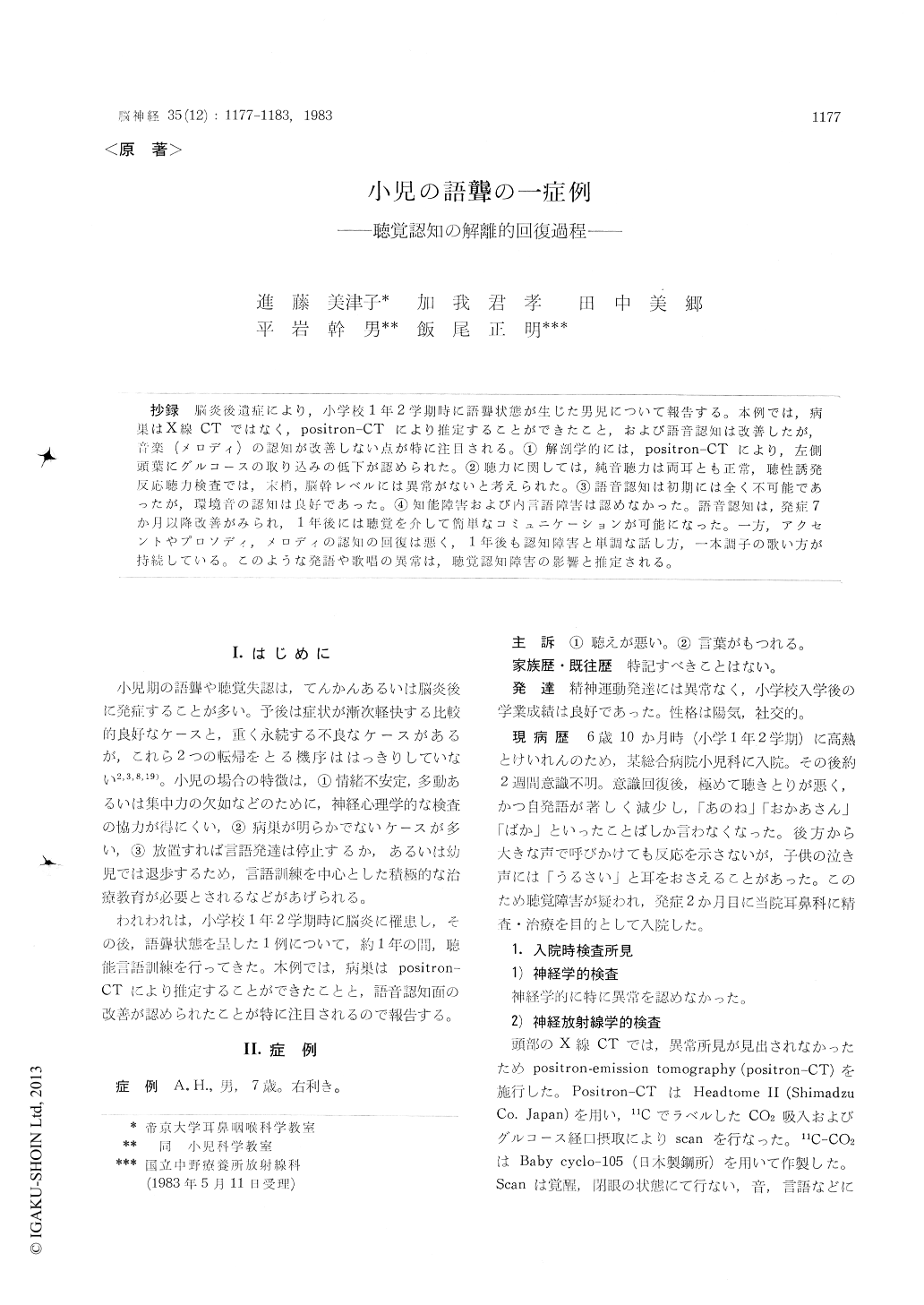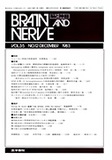Japanese
English
- 有料閲覧
- Abstract 文献概要
- 1ページ目 Look Inside
抄録 脳炎後遺症により,小学校1年2学期時に語聾状態が生じた男児について報告する。本例では,病巣はX線CTではなく,positron-CTにより推定することができたこと,および語音認知は改善したが,音楽(メロディ)の認知が改善しない点が特に注目される。①解剖学的には,positron-CTにより,左側頭葉にグルコースの取り込みの低下が認められた。②聴力に関しては,純音聴力は両耳とも正常,聴性誘発反応聴力検査では,末梢,脳幹レベルには異常がないと考えられた。③語音認知は初期には全く不可能であったが,環境音の認知は良好であった。④知能障害および内言語障害は認めなかった。語音認知は,発症7か月以降改善がみられ,1年後には聴覚を介して簡単なコミュニケーションが可能になった。一方,アクセントやプロソディ,メロディの認知の回復は悪く,1年後も認知障害と単調な話し方,一本調子の歌い方が持続している。このような発語や歌唱の異常は,聴覚認知障害の影響と推定される。
The patient was a right-handed boy. Pregnancy and delivery were normal. There were no neona-tal complications. His development was normal until the age of 6 years and 10 months when he suddenly fell into coma. He was admitted to a hospital, where he was diagnosed as having ence-phalopathy of unknown cause. It was found that he did not respond to verbal stimuli after recovery from coma. He was reffered to our hospital for detailed examination of hearing at the age of 7 years, and received neuroradiological and audio-logical examinations including X-ray CT, positron-CT, behavioral audiometry, auditory evoked re-sponse audiometry as well as other hearing and speech tests. Pure tone audiometry showed that auditory thresholds for pure tones ranging from 125 to 8, 000 Hz were normal, while speech audio-metry demonstrated that he was unable to discri-minate test words. However, he accurately recog-nized environmental sounds and noises as well as sounds produced by musical instruments. The decreased uptake of 11C-glucose at the left tem-poral lobe was demonstrated by positron CT, although no abnormality was showed by X-ray CT. WISC-R showed he had normal intelligence. ITPA demonstrated that the psycholinguistic abi-lity via visual channel remained intact, whereas auditory memory and auditory closure were mar-kedly impaired. The boy had no difficulties in reading, naming and writing. Speech therapy was started as soon as diagnosis of word deafness was made. Until 6 months after onset, he never understood and repeated what was said to him. Therefore, speech-reading, writing or drawing and gestures were introduced for communication with him. He had some articulation disorders including distortion and substitution of consonants. He showed spelling errors and phonemic para-phasia when he voluntarily wrote or spoke. Beha-viorally he was hyperactive, restless, and emotio-nally unstable. He returned to school two months after onset. He was tested 7 months after onset, and it was observed that he had become auditorily to understand words to some extent. However, it was considerably difficult to understand what he said, because he became to speak very fast, and monotonously. One year after onset, he had become to listen carefully to what was said to him and understand even short sentences, auditorily. It was reported that he was not doing well in school. Speech cognition tests which were developed in our laboratory demonstrated that he was unable to recognize some phonemic and prosodic features including accents of words as well as familiar me-lodies.His spontaneous speech was still monotonous. Disprosody observed on the patient's speech may be explained by the influence of the defective prosodic analyser which causes auditory perceptual disorders including cognitive defects of accents, prosodic aspects of speech as well as melodies.

Copyright © 1983, Igaku-Shoin Ltd. All rights reserved.


